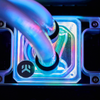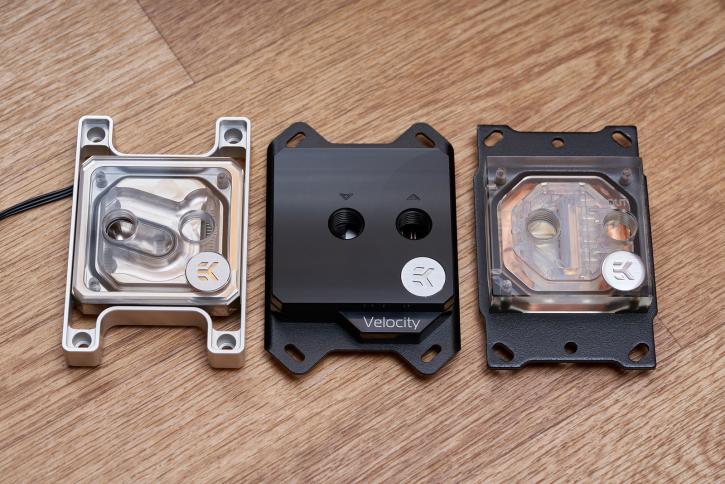The test setup
The test setup
- Processor: AMD Ryzen 9 3900X (12c/24t);
- Motherboard: ASUS ROG CROSSHAIR HERO 8 Wi-Fi (UEFI v1302);
- Memory: Corsair Vengeance LPX 4133C19;
- Video card: SAPPHIRE RX VEGA64 NITRO+;
- NVMe : Gigabyte Aorus NVMe Gen4 SSD 2TB;
- NVMe: Samsung 960 PRO 512 MB;
- Power supply: Corsair HX750i;
- CPU cooling: EKWB Supremacy EVO;
- CPU Cooling: EKWB Quantum Velocity;
- CPU cooling: EKWB Quantum Magnitude;
- Pump: EKWB Quantum Kinetic;
- Radiators: 2x EKWB CoolStream 360 PE;
- Fans: EKWB Vardar F3 120;
- Flow and temperature sensors from BARROW;
- Thermal paste : ARCTIC MX-4;
- Case : Fractal Design Meshify S2 TG White;
- OS: Windows 10 x64 1909;
- Chipset driver: AMD 2.01.15.2138.
Test Methodology
Testing waterblocks has always been a routine job, because not only every degree is important, but every tenth degree is otherwise we may not see the difference. Huge amount of time for preparation and for runs contributes to it. Another reason for a certain "dislike" of water block tests by reviewers - it is impossible to give the exact result that the user wants to get. And all why? Length of tubes, number of bends, bending angle, loop materials, radiator thickness, radiator fins density, radiator size, individual contact between processor and waterblock, amount of heat energy produced and other factors make it impossible to give an exact answer because every user system is a special case. The only way to evaluate a waterblock's performance is to evaluate the amount of heat transferred by the waterblock to the water, and the more heat is "transferred" to the water, the better. Water acts as a battery in this case.
Testing methodology
There are quite a few testing methodologies, which always cause a huge number of disputes. Without changing this tradition, we want to offer our own testing methodology. Its essence is simple, we subtract the average water temperature in a warmed up circuit from the average processor temperature for a certain period of time after the circuit was warmed up. Since the water in the liquid state does not change its properties of heat transfer and heat capacity (to be exact, the changes are very small to include them in the calculation), we can not worry that the water in the circuit after 19 minutes of the test will change by 1 degree. As I wrote earlier, water is a heat accumulator and the final result of the water block performance will remain the same because 1 degree of water temperature will be equal to 1 degree of the processor, which will eventually be mutually deducted. In most runs, the starting point was the water temperature in the circuit equal to 29 degrees. At the same time, a more productive water block managed to warm it up to 32 degrees, although it used as much as 2 radiators EKWB CoolStream 360 PE.
Many of you have already experienced (or are still ahead of you) the phenomenon of Ryzen processors producing strange temperature peaks, which, although lasting a fraction of a second, but at sub-maximum temperatures can send the system into a reboot (protection).
- So the first and most important condition for monitoring is low response time to understand which waterblock the unit is capable of taking these peaks and which is not. Therefore, a sensor polling time of 1000 ms has been selected. The sampling time is 20 minutes, which equals 1200 readings for each sensor (water temperature, flow rate and processor temperature). The number of runs is 3 for each water block and for each value of water flow rate. The final value is an arithmetic mean.
- The second condition of the test is a constant laminar flow, for this purpose, the pump RPMs were selected individually for each water block to reach the cherished 4.3 liters per minute. The number 4.3 l/m was taken for a reason, there are quite a few studies that show that 1GPM (gallon per minute) will be an effective enough value for heat exchange in the chain processor->water block->water->radiator>air. Also as a bonus, I tested the blocks in 1.65GPM (6.2 l/m) and 2.15GPM (8.2 l/m) modes.
- The third condition is that the fans are always 1285 rpm. Optimum performance for generating sufficient static pressure to "blow" the EKWB CoolStream 360 PE radiators, but with adequate noise performance.
- The fourth condition is a room temperature of 25 degrees, which was maintained by a system with a remote sensor. This sensor made it possible to control the temperature of the air mass near the test bench very accurately.
We will evaluate each water block using the AIDA FPU's toughest stress test with the hottest AVX2 instructions. In addition to the AVX2, this stress test occasionally caused spontaneous temperature peaks, which automatically added value to the test. The TDP packet was selected to be 165W. You may be confused by this value, because it is quite small by the standards of modern processors, but there is a nuance here. The protection system of my 3900X was triggered at 88-89 degrees (95 degrees), so I needed the optimal value so that the temperature peaks during the stress test would not send the system to the reboot.
If an abnormal result was observed, the water block was reassembled and new installation conditions were made accordingly.


